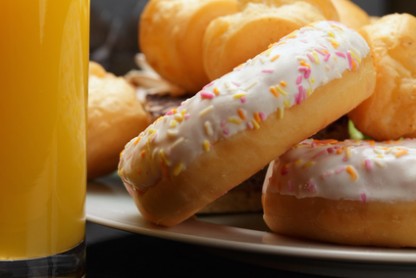Sugar Addiction – New Study Validates All Carb Calories Are NOT Created Equal
 Could the bagel and orange juice you have for breakfast set you up for sugar addiction and make you crave sugary foods and drinks, white bread and other processed carbohydrates for lunch? Will the fries and soda you eat with your lunch make you hungrier at dinner and drive you to overeat? A new study strongly suggests the answer to these questions is “yes.” Sugar addiction may be real after all. Researchers from the New Balance Foundation Obesity Prevention Center at Boston Children’s Hospital designed the most sophisticated study to date showing the stimulating effects of high glycemic carbohydrates on the brain’s craving, reward, and hunger systems.
Could the bagel and orange juice you have for breakfast set you up for sugar addiction and make you crave sugary foods and drinks, white bread and other processed carbohydrates for lunch? Will the fries and soda you eat with your lunch make you hungrier at dinner and drive you to overeat? A new study strongly suggests the answer to these questions is “yes.” Sugar addiction may be real after all. Researchers from the New Balance Foundation Obesity Prevention Center at Boston Children’s Hospital designed the most sophisticated study to date showing the stimulating effects of high glycemic carbohydrates on the brain’s craving, reward, and hunger systems.
What are high glycemic carbs and how do they lead to sugar addiction?
High glycemic carbs, like sugar and white flour, are those carbs that lead to quick spikes and drops in blood sugar. The study’s findings, published in the American Journal of Clinical Nutrition, show how these foods, independently of their taste, intensely stimulate the same parts of the brain involved in drug addiction, altering brain activity in a way that makes us crave them even more. The results add more support to the controversial idea that food addiction, especially carb and sugar addiction, is a real cause of overeating.
“This research suggests that based on their effects on brain metabolism, all calories are not alike,” said Dr. David Ludwig, the lead author of the study. “Not everybody who eats processed carbohydrates develops uncontrollable food cravings. But for the person who has been struggling with weight in our modern food environment and unable to control their cravings, limiting refined carbohydrate may be a logical first step.”
For the randomized, double-blind study, the researchers fed vanilla milkshakes to 12 obese men on two different occasions. Except for their glycemic load, the milkshakes were identical in nearly every way, including taste and appearance. They all contained milk and vanilla and had the same amount of calories, carbohydrates, protein and fat. The only difference was that on one occasion, the vanilla shakes contained high-glycemic corn syrup while on the other they contained an alternative low-glycemic source of carbohydrates. The researchers verified that the men had no preference for one milkshake over the other.
High glycemic foods lead to abnormally low blood sugar and excessive hunger 4 hours later
Compared to the low glycemic milkshake, blood sugar levels initially increased more quickly in response to the high glycemic shake, just as expected. But four hours after the high glycemic shakes, blood sugar levels plummeted into the abnormally low (hypoglycemic range). The investigators were particularly interested in this critical time point since it is known to influence eating behavior at the next meal.
What they found at the four-hour mark was that not only did the high glycemic milkshakes induce hypoglycemia, but compared with the low glycemic shakes they increased hunger and selectively stimulated brain regions that regulate cravings, reward and addictive behaviors. Every single subject reported being hungrier, and brain scans showed greater activation and blood flow in the nucleus accumbens, the key area of the brain responsible for cravings and addiction which gets “hijacked” by drugs of abuse. Sugar addiction, it appears, also triggers this part of the brain.
Sugar addiction is mainly the result of altered brain activity after eating high glycemic foods
The results showed that highly processed carbohydrates such as white bread and sugar, “alter brain activity in ways that make us crave them even more,” said head-researcher Dr. Ludwig.” We think we have shown for the first time that refined carbohydrates’ biological effects can provoke, independent of calories and tastiness, symptoms related to addiction in susceptible people — those who are overweight or obese,” he said. Whether or not such sugar addiction might also occur in non-obese people waits to be seen.
How to beat sugar addiction
The ‘eat less, exercise more’ approach to weight loss carries with it the underlying assumption that ‘a calorie is a calorie.’ The new research, however, provides the most convincing evidence to date that it isn’t just the amount of food we are eating, but also the type. If you think you might have a sugar addiction or are frustrated because of uncontrollable carb or sugar cravings or the inability to permanently lose weight, switching to a low glycemic diet—a way of eating which avoids sugar, fruit juice, sweetened beverages, white rice, white flour, and refined/processed carbohydrates— might be the answer. This type of diet treats sugar addiction by stabilizing blood sugar levels, prevents blood sugar from plummeting, and doesn’t activate the brain’s craving and reward systems. The result is fewer cravings and no excessive hunger. Plus, by avoiding high glycemic foods, you’ll be more likely to replace them with foods that contain more vitamins, minerals, and fiber, and disease-fighting phytochemicals.


 Ask the EN Experts March 2025
Ask the EN Experts March 2025  Vegan Diet Better Than Omnivore Diet for Cardiovascular Health
Vegan Diet Better Than Omnivore Diet for Cardiovascular Health 